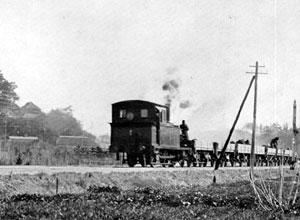Steam Locomotive
| 
No.7 (I.W.collection) |
|
No.6 and 7 were manufactured at the Avonside Engine Company during 1870 - 1871,
their manufactured numbers were 834 and 835.
During 1876, Tokyo area engine numbers were changed to odd numbers. From this amendment, No.6 was changed to No.5. (No.7 was not changed). They were used on the Shinbashi - Yokohama line until June 1884, but during the spring of 1885, they were lent to the semigovernmental railroad corporation Nippon Railway, and were used between Nakada (Koga city) and Utsunomiya. And they were returned during November 1886. No.7 was moved to the Sagami river bridge for construction on the Tokaido line. And No.5 went to Numazu and was used for Tokaido line construction. After completion of the Tokaido line, both engines were returned back to Shinbashi - Yokohama, and were used for none- commercial operations. (backup to construction etc ....) A mystery still remains as to what actually happened to the engines.... A paper recorded that "Two engines (no record as to what classes) were moved out to Formosa (Taiwan - Taiwan was a Japanese territory during 1895 to 1945)". These "Two-Engines were speculated to as being No.5 (ex-No.6) and No.7. But on the Taiwan end, they stated that there was only one engine and it was No.7. So where had No.5 engine gone ..... ? Was another engine sent to Taiwan ? not No.5 ?? One theory states that No.5 may have been scrapped in Japan, ..... while another supposition is, that it fell from a ship while being transported to Taiwan ...... There is one assumption ..... During the 4th of October 1901, a Japanese ship named the "Tsuruhiko-maru" sailed from Kobe to Taiwan. It was carrying a steam locomotive. But, the Tsuruhiko-maru was shipwrecked by a typhoon, and sank offshore near Nagasaki Goto Island during the 7th of October 1901..... and 48 passengers died. This ship carried "One Steam engine" and it was Kisha Seizo Co's No.1 engine (2-4-2 Tank Engine the same as Class 800).... as originally-conceived. But there is another theory that, Kisha Seizo's No.1 engine had already arrived on Taiwan on another ship at an earlier time. So, it is very possible that the engine on the Turuhiko-maru was engine No.5 !? This later theory seems to be the most accepted theory during recent years. And further, there is another theory that, Shigehiro Kaneda estimated in his book " Japanese Steam Locomotive History " that, Tsuruhiko-Maru carried two engines as follows. ' There is a record (Sept 1901 in JGR) that Kisha company's No.1 was loaded on the "Taichu-Maru" which sailed on September 1901, but, for some reason, the ship was changed to the "Tsuruhiko-Maru", and Kisha No.1 sank with No.5. ' ... no one knows the true story. But, one thing is for sure, No.5 engine didn't arrive in Taiwan. During 1901, No.7 arrived Taiwan. And later No.7 was renamed No.9 during 1906. It was used for South Taiwan's main line construction. No.9 was active until 1926 and then it retired. After retirement, No.9 was preserved at Taihoku park. Taihoku park was renamed to " 228 Peace Memorial Park " during February 1996. But, the engine remained in dilapidated condition for a long time. During Jul 2003, a new exhibition shed was built, and it can now be seen in a glass-shed. |
No.9 in Taipei Museum
(Photo links " A3 steam locomotives in Taipei.JPG " Wikipedia page.)
| Configuration | 2-4-0 | Dimensions Length (mm) | 7912
| Engine Weight (Operating tons) | 24.59
| Driver size (mm diameter) | 1219
| Boiler pressure (Kg/cm2) | 8.4
| |
|
No.6 |
No.7 | |||||||||||||||||||||||||||||||||||||||||||||||||

Names during the 5 year period 1876-1900 (Photo S.Kawakami position) |

Oiso, Tokaido line (Photo credit to Railway Museum) Biographic Data Chart No.6
Biographic Data Chart No.7
|
Introduction
|
Go to Top
|